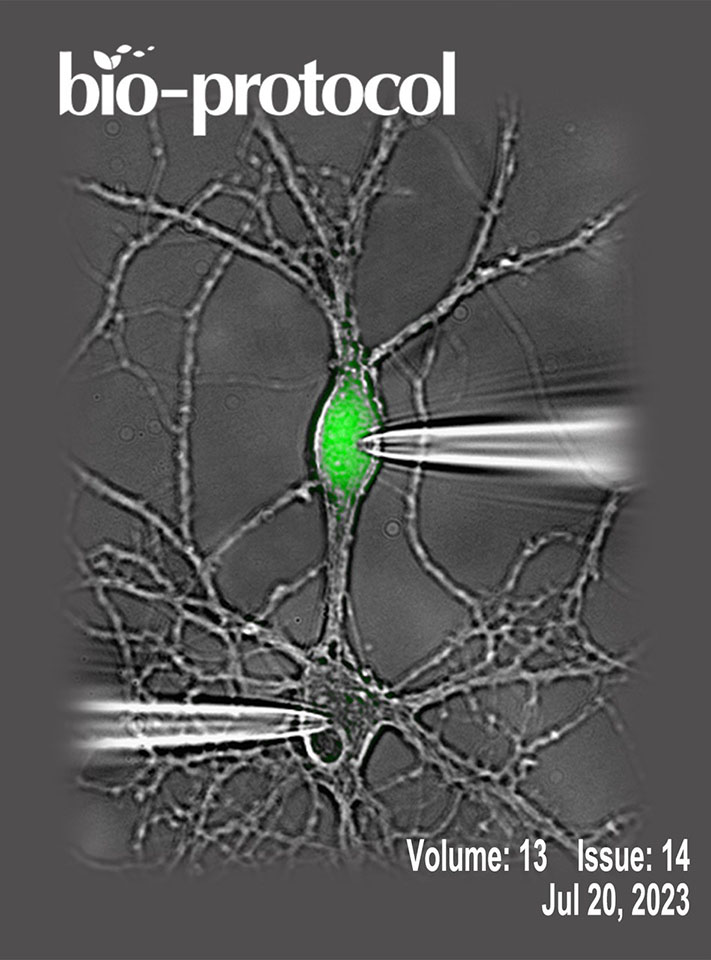The Art of Neuroscience: Synaptic Transmission and Plasticity in Isolated Neurons
Research Team at the Karl Landsteiner University of Health Sciences develops novel protocol for studying isolated pairs of hippocampal neurons. Dedicated work honoured by cover page in Bio-protocol Journal.
Studying the complex interactions between synaptic nerve endings as well as their development has now become much easier. Thanks to a method developed by scientists of the Karl Landsteiner University of Health Sciences (KL Krems) in Austria, it is now possible to study isolated pairs of neurons under controlled conditions. Also, for the first time, it now is possible to analyze pre- and postsynaptic effects of wild-type and/or genetically modified synapses in a simple neuronal network. This methodological advance will significantly ease the investigation of synaptic mechanisms and, at the same time, reduce the number of experimental animals in such studies. It now has been published in Bio-protocol Journal and the article is featured on the cover of the latest issue.
Nerve signals are sent quickly and over long distances. This requires complex physiological activities between the ends of different nerve cells (neurons), the synapses. Here, neurotransmitters are released and bound by receptors, as well as recycled again by later uptake mechanisms. Studying this intricate interaction is difficult, as in most established experimental models neurons are interconnected with many other neurons, and activities at one synapse cannot be regarded as independent of influence by others. Furthermore, most experimental set-ups only allow the analysis of mono-directional transmission, i.e., studying only pre- or postsynaptic effects, and only between certain types of cells. Now a method developed by a team at the Division of Physiology at the KL Krems has changed all that.
Preparation & Isolation
“If you want to understand how two kids interact with each other, you better don’t watch them in the hustle and bustle of a kindergarten,” draws Prof. Gerald J. Obermair an analogy to his recent work. “You wait until it’s just the two of them. This is exactly what our method allows for studying neurons.” Indeed, the new method allows the experimental analysis of isolated neurons. The tricks that Dr. Ruslan Stanika, a scientist in Obermair’s team at the Division of Physiology, employs are far from rocket science – they are just the result of a lot of hard work and experience. This was required to find the exact right conditions for growing mouse hippocampal neurons in cell cultures in such a way that they allow bi-directional measurements of synaptic functions in isolated paired neurons. Now this method has been published in painstaking detail in Bio-protocol Journal and is available to colleagues throughout the world. In this way, they can all benefit from the several advantages this method offers over existing ones, which quite often rely on micrometer-thin slices of mouse brain.
An immediate advantage of the method is the easy identification of those cells that are usable for measurements. A task that is hampered by excessive wiring of nerve cells in other cell culture protocols. Following the new protocol, all synapses used for analysis are formed between the paired neurons under observation. This in turn results in increased amplitudes of postsynaptic responses and hence allows the reliable detection of changes in postsynaptic receptor function.
To & Fro
But the goodies this method offers don’t stop there, as Prof. Obermair explains: “Both cells of the cultured paired network can function as stimulated, i.e., presynaptic, and innervated, i.e., postsynaptic neurons. For the first time, this allows the bi-directional measurement of synaptic transmission in isolated paired neurons”. This is particularly relevant as the protocol also allows the genetic alteration of one of the two paired neurons (by overexpression or knockdown of specific genes). “In this way” explains Dr. Stanika, “one now can analyze the pre- and post-synaptic consequences of genetic modifications, for example disease mutations, in one paired neuron in comparison with wild-type synaptic connections in the same neuronal network.” As proof of principle, in a study published in the Journal of Neuroscience in 2019, the two scientists of the KL Krems’ Division of Physiology altered a protein (α2δ) that forms a subunit of calcium channels and at the same time acts as a critical synaptic organizer.
All in all, the new protocol that is featured on the cover of the recent Bio-protocol Journal issue lays the foundation for significant advances in neuroscience. This is also of interest to students of a planned PhD Program in Mental Health and Neuroscience at the KL Krems who will have the chance learning first-hand one of the currently most advanced methods for studying paired cultured hippocampal neurons.
Original publications:
- An ex vivo Model of Paired Cultured Hippocampal Neurons for Bi- directionally Studying Synaptic Transmission and Plasticity. Stanika, R. & Obermair, G. J. (2023). Bio-protocol 13(14): e4761. DOI: 10.21769/BioProtoc.4761.
- Presynaptic α2δ-2 Calcium Channel Subunits Regulate Postsynaptic GABAA Receptor Abundance and Axonal Wiring. Geisler S, Schöpf CL, Stanika R, Kalb M, Campiglio M, Repetto D, Traxler L, Missler M, Obermair GJ (2019). J Neurosci. 39(14):2581-2605. doi: 10.1523/JNEUROSCI.2234-18.2019. [Proof of concept study]





